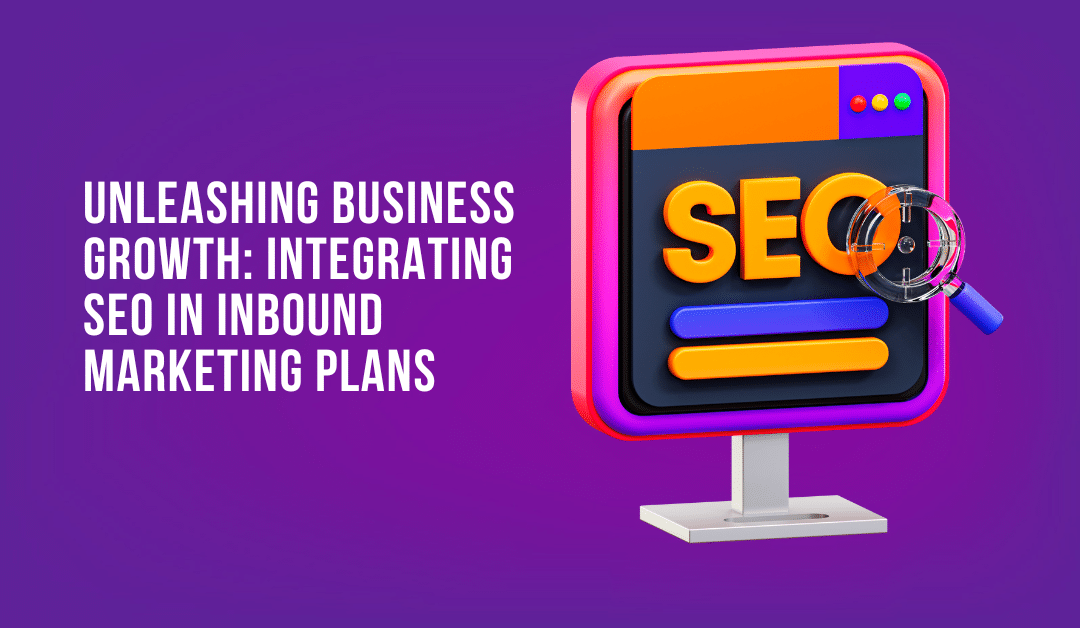Unleashing Business Growth: Integrating SEO in Inbound Marketing Plans
Introduction
In the maze of digital marketing, navigating towards business growth can seem daunting. With all the buzzwords flying around, it’s easy to feel overwhelmed. You’ve likely heard about Search Engine Optimization (SEO) and Inbound Marketing, two powerful strategies that can boost your brand’s visibility and convert leads into loyal customers. But have you ever wondered how integrating SEO into your inbound marketing plans can supercharge your brand’s growth?
In this article, we’ll dive into the intersection of SEO and inbound marketing, and how their fusion can unleash a storm of business growth. We’ll also discuss practical strategies and steps to integrate SEO into your inbound marketing plans, complete with a case study that demonstrates the power of this integration.
If you’re a marketer looking to take your brand to new heights, or a business leader seeking innovative ways to increase leads and conversions, this guide is your roadmap. Let’s plunge into the exciting world of SEO-integrated inbound marketing.

Understanding SEO and Inbound Marketing
What is SEO?
Search Engine Optimization (SEO) is the process of optimizing a website to improve organic traffic from search engines. It involves enhancing the site’s visibility and making it more appealing to search engines. This is achieved by optimizing various elements of your website, including its structure, speed, content, and more. The goal is to appear in the top results when users search for specific keywords related to your business or industry.
What is Inbound Marketing?
Inbound marketing, on the other hand, is a strategy that focuses on attracting potential customers by providing valuable content and experiences tailored to them. It’s about creating meaningful connections and solving problems for your audience. This method pulls in customers organically, rather than pushing out messages to a broad audience, as traditional marketing methods might do. Inbound marketing strategies often include content marketing, SEO, social media marketing, and more.
The Intersection of SEO and Inbound Marketing
While SEO and inbound marketing can be viewed as separate strategies, they actually complement each other exceptionally well. The intersection of SEO and inbound marketing is where you’ll find the most potent combination for business growth.
Inbound marketing strategies create the valuable, high-quality content that your target audience is looking for, and SEO ensures that this content is easily discoverable on search engines. In short, SEO can amplify the reach of your inbound marketing efforts, while inbound marketing provides the valuable content that SEO needs to be effective.
Together, they work in harmony to attract, engage, and delight your audience, leading to increased website traffic, lead generation, and ultimately, customer conversion. The integration of SEO in your inbound marketing plan can undoubtedly unleash significant business growth.
By understanding the role of SEO in inbound marketing, you can create a more comprehensive, effective marketing strategy. This is not about choosing between SEO and inbound marketing—it’s about integrating both to drive maximum impact. In the following sections, we’ll delve deeper into how to effectively integrate SEO into your inbound marketing strategy.

The Role of SEO in Inbound Marketing
To truly seize the potential of your inbound marketing strategy, it’s vital to understand the role of SEO within it. SEO, when seamlessly integrated into inbound marketing, acts as a catalyst for business growth, attracting and converting leads, providing valuable market insight, and helping you efficiently target your audience.
Attracting and Converting Leads with SEO
SEO is your enchanted spotlight in the digital marketing world. It attracts organic traffic to your website by optimizing your content and ensuring that it’s visible to your potential customers. But SEO isn’t just about attracting leads—it’s also about converting them.
When you create SEO-oriented content, you’re doing more than just stuffing it with keywords. You’re providing valuable insights and solutions to your audience’s pain points, thereby establishing trust and a positive brand image. This in turn increases the chances of converting these leads into customers. Remember, the goal is not to trick the algorithm but to provide genuine value to your audience.
SEO as a Tool for Market Research
SEO is a powerful tool for market research. An in-depth keyword analysis can offer valuable insights into what your potential customers are searching for and the language they’re using to do so. This information can inform your content creation, ensuring your offerings match your audience’s needs and search habits.
Additionally, the more SEO-focused content you produce, the more data you have to analyze. By studying the performance of various keywords and content types, you can gain a clearer understanding of your market and refine your marketing strategy accordingly.
SEO for Audience Targeting
SEO plays a significant role in audience targeting. By using carefully selected keywords in your content, you’re not just improving your search engine ranking—you’re also making sure your content reaches the right people.
For instance, long-tail keywords—specific phrases with lower search volume but less competition—can help you attract a more defined audience. These keywords are generally used by customers who are in the later stages of the buying cycle, making them more likely to convert.
In essence, SEO allows you to speak directly to your audience in a language they understand, drawing them in with valuable content that addresses their needs and interests. This precision targeting is key to maximizing the impact of your inbound marketing strategy.
In conclusion, SEO is not just a technical aspect of website optimization. It’s an essential component of your inbound marketing strategy, attracting and converting leads, providing valuable market insights, and enabling effective audience targeting. By integrating SEO into your inbound marketing plans, you’re setting your business up for growth and success.

Strategies for Integrating SEO in Inbound Marketing Plans
A well-thought-out SEO strategy doesn’t emerge in a vacuum. It’s a crucial part of your inbound marketing plan, woven intricately into every stage of your customer’s journey. Let’s dive into the key steps to successfully integrate SEO into your inbound marketing strategy.
Defining Your Target Audience
First things first, you need to understand who your audience is. Are they professionals looking for industry insights? Or are they nonprofit leaders seeking effective marketing solutions? By clearly defining your target audience, you can identify the keywords and phrases they’re likely to use when searching for solutions online. Remember, the ultimate goal of SEO and other marketing techniques is to provide content that solves your audience’s pain points. So, comprehensive audience analysis can guide you in crafting dedicated marketing strategies that resonate with your audience and save you resources.
Mapping Channels and Content Types to Funnel Stages
Next, you need to align your channels and content types to the right stages of your marketing funnel. Your audience’s needs and behaviors change as they move from the awareness stage, through the consideration stage, to the decision stage. By mapping out this journey, you can create SEO-oriented content that effectively guides them through each stage, increasing the chances of conversion.
Implementing a Content Audit
A content audit can be a game-changer in your SEO strategy. By reviewing your existing content, you can identify what’s working, what’s not, and where there’s room for improvement. An audit can uncover opportunities to optimize old content with high-performing keywords, add internal links, or address gaps in your content that your target audience is searching for.
Prioritizing SEO-Oriented Content Creation
Content is king, but only if it’s SEO-optimized. Prioritize creating content that not only resonates with your audience but also aligns with search engine algorithms. This involves using long-tail keywords with high search volume and low competition, avoiding keyword stuffing, and ensuring your content provides unique insights or solves a pain point.
Building an Authentic Social Media Presence
Finally, don’t underestimate the power of social media in your SEO strategy. An authentic social media presence can amplify your content reach and engagement, indirectly boosting your SEO performance. Remember, social media itself is a form of content marketing, so it’s essential to create strategic and targeted content that resonates with your audience.
By implementing these strategies, you can create a seamless integration of SEO in your inbound marketing plan, setting your business up for sustainable growth.

Practical Steps to Integrate SEO in Inbound Marketing
Let’s dive into the practical steps you can take to integrate SEO in your inbound marketing plan. These steps will help you carve out a unique space in the digital landscape and ensure your content reaches the right audience.
Keyword Research and Competitor Analysis
A critical step in SEO is identifying the keywords that your target audience uses when they’re searching for products or services similar to yours. This involves researching and selecting the most relevant keywords, and then strategically incorporating them into your content. High-volume, low-competition keywords can be a goldmine for driving organic traffic.
Simultaneously, keep a close eye on your competitors. Analyze their SEO practices, observe the keywords they’re ranking for, and identify gaps that you can fill. This competitive analysis can offer valuable insights and help you outrank them in search engine results.
Optimizing Site Health and User Experience
SEO isn’t just about keywords. It’s also about making your website user-friendly. A healthy, well-optimized website loads quickly, is easy to navigate, and is mobile-friendly. Regularly checking your website health and making the necessary improvements can significantly boost your SEO.
Additionally, ensure your website offers a superior user experience. This includes factors like intuitive navigation, engaging content, and a design that’s easy on the eyes. After all, the longer visitors stay on your site, the better your chances of converting them.
Tracking Keyword Rankings and SEO Performance
Once you’ve implemented your SEO strategies, it’s crucial to track their effectiveness. Regularly monitor your keyword rankings and overall SEO performance. Tools like Google Analytics can provide valuable data on your website’s traffic, bounce rate, and the behavior of your audience.
This tracking can help you understand what’s working and what isn’t, allowing you to tweak your strategies accordingly.
Measuring the Impact of SEO on Inbound Marketing
Lastly, measure the impact of your SEO efforts on your inbound marketing. Are you attracting more organic traffic? Are your conversion rates improving? Are you generating more leads or sales?
These metrics can help you gauge the success of your SEO strategy and its contribution to your inbound marketing. Remember, the ultimate goal is not just to drive traffic but to attract the right audience who’s genuinely interested in your offerings and is likely to convert.
By systematically integrating SEO into your inbound marketing plan, you can unlock unprecedented business growth. It’s a process that requires ongoing effort and fine-tuning, but the rewards – increased visibility, higher organic traffic, and improved conversion rates – are well worth it.
Case Study: Successful Integration of SEO in Inbound Marketing
Imagine being able to increase your brand’s visibility, organic traffic, and conversion rates by simply refining your inbound marketing strategy. It may sound like a tall order but integrating SEO into your inbound marketing plan can yield these impressive results. To illustrate how this can work in practice, let’s delve into a real-life success story.
In this case, a small business was struggling to maintain a steady flow of organic traffic and leads due to fierce competition in their industry. They had a solid inbound marketing strategy in place but weren’t leveraging SEO to its full potential. This was reflected in their website’s low search engine rankings and lack of visibility among their target audience.
The business decided to revamp their approach and integrate SEO into every aspect of their inbound marketing plan. This involved defining their target audience, mapping channels, and content types to funnel stages, carrying out a comprehensive content audit, and prioritizing the creation of SEO-oriented content.
Their new SEO strategy also included a strong emphasis on building an authentic social media presence. By sharing valuable content that resonated with their target audience and using SEO-friendly practices, they significantly increased their brand’s exposure on social platforms.
Within a few months of implementing these changes, the business began to see a marked improvement in their search engine rankings. Their organic traffic increased by nearly 60%, and their conversion rates skyrocketed. The success of their new SEO-driven inbound marketing strategy was undeniable.
This case study serves as a testament to the power of integrating SEO into inbound marketing. When applied effectively, these strategies can work together to attract, engage, and convert leads. Ultimately, this leads to increased brand awareness, a steady flow of organic traffic, and tangible growth for your business.
In the next section, we’ll outline practical steps you can take to integrate SEO into your own inbound marketing plans.
Conclusion
The key to a successful inbound marketing strategy lies in its ability to attract, engage, and convert potential customers, and SEO plays a pivotal role in making this possible. Integrating SEO into your inbound marketing plans is a powerful approach that can significantly boost your online visibility, increase organic traffic, and promote your brand in a way that resonates with your target audience.
From defining your target audience to optimizing your site health and user experience, from tracking keyword rankings to measuring the impact of your SEO efforts, each step plays a crucial role in amplifying your marketing efforts. By leveraging these strategies, you stand to not only attract a greater volume of traffic but also engage and convert these visitors into loyal customers, thereby driving business growth.
In the digital world, standing out among competitors can be a daunting task. But with a well-rounded marketing strategy and a focus on creating authentic, SEO-oriented content, you can significantly enhance your brand’s visibility and carve a niche for yourself in the market.
As demonstrated by the case of ESCA, entrusting your marketing tasks to a specialized agency like epIQ Creative Group can lead to substantial time savings, boost social engagement, and create a consistent brand image that appeals to your target audience. This case study underscores the potential of a robust SEO integrated inbound marketing strategy in surmounting marketing obstacles and unleashing the full potential of businesses.
In conclusion, integrating SEO into your inbound marketing plans is not just a valuable addition—it’s a necessity in today’s digital landscape. It’s an investment that can propel your brand to new heights, foster customer loyalty, and ultimately, drive serious business results.
About epIQ Creative Group
In the realm of digital marketing, there’s a company that stands out with its unique approach, a deep understanding of the industry, and a fierce commitment to client success—epIQ Creative Group.
Services Offered by epIQ Creative Group
epIQ Creative Group offers a wide array of design services that empower businesses to execute their marketing strategies with confidence. They provide everything from banners and logos to email copywriting and video production, offering a comprehensive range of services to meet every marketing need. They even offer digital and print material design, as well as innovative event and conference promotion gadgets.
The Quantum Circle™ Program
epIQ Creative Group has developed a unique methodology called the Quantum Circle™ Program. This approach involves three simple steps: sign up, pick the assets, and enjoy the final product. It’s designed to streamline the process of creating and deploying marketing materials while also ensuring that everything is tailored to your brand’s specific needs and goals.
Turning Session Videos into Sneak-Peak Content
Understanding the value of content repurposing, epIQ Creative Group has introduced a service called “Clips2Tips,” which is all about turning session videos into sneak-peak content. This strategy can enhance the visibility of your events and engage your audience in a whole new way by offering them enticing snippets of what they can expect.
Giving Events the Social Buzz They Deserve
epIQ Creative Group also offers “Live2Social,” a service designed to give your event the social buzz it deserves. This approach leverages the power of social media to amplify the reach of your events and generate a wave of engagement.
In a world where standing out from the crowd is crucial, epIQ Creative Group provides creative, high-quality, and strategic marketing solutions designed to elevate your brand and leave a lasting impact on your audience.

